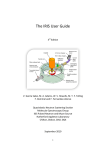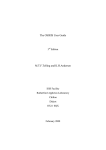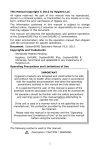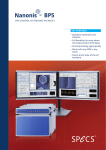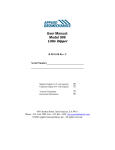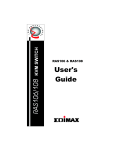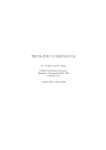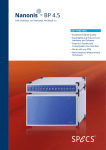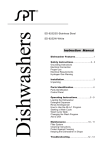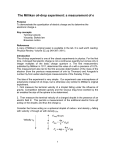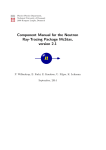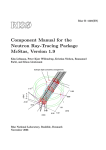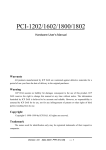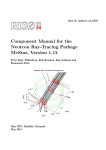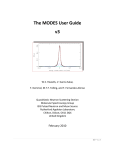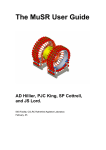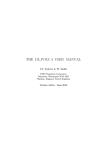Download The IRIS User Guide
Transcript
The IRIS User Guide 2nd Edition M.A.Adams, W.S.Howells and M.T.F.Telling ISIS Facility Rutherford Appleton Laboratory Chilton Didcot OX11 0QX January 2001 PREFACE This User guide contains all the information necessary to perform a successful neutron scattering experiment on the IRIS high resolution inelastic spectrometer at ISIS, RAL, UK and supersedes ‘The IRIS User Guide, M.A.Adams, RAL Technical Report, RAL-TR-97-052’. Since IRIS is a continually evolving and improving instrument some information contained within this manual may become redundant. However, the basic instrument operating procedures should remain essentially unchanged. While updated manuals will be produced when appropriate, the most comprehensive source of information concerning IRIS is the Instrument Scientist /Local Contact. It would be appreciated, however, if this User guide were the first point of call should problems arise. 2 ACKNOWLEDGEMENTS It is a pleasure to acknowledge all those who have contributed to the production of this User guide. In particular, past and present members of the Molecular Spectroscopy Group at the ISIS facility, UK, for fruitful discussion and comments. 3 CONTENTS 1. Introduction 6 1.1 The Instrument 6 1.2 Principle of Operation 10 1.2.1 Quasi / in-elastic neutron scattering 10 1.2.2 Diffraction 11 2. Performing an experiment on IRIS 2.1. 12 Before arriving at IRIS 12 2.1.1. The User Office, film badges and swipe cards 12 2.1.2. Sample safety assessment 13 Selecting sample cans and scattering geometry 13 2.2.1. Flat plate cans 13 2.2.2. Annular / cylindrical cans 15 2.3. Loading a sample into the neutron beam 16 2.4. The beam line shutter interlock system 16 2.5. IRIS computing overview 17 2.6. Suitable instrument settings 18 2.7. Chopper control 19 2.7.1 Changing chopper frequency 19 2.7.2 Changing chopper phases 19 2.2. 4 2.8. Data collection 20 2.8.1. CHANGE 20 2.8.2. BEGIN 21 2.8.3. Data Inspection 21 2.8.4. END and end of an experiment 21 3. IRIS Computing 3.1. 3.2 4. 22 Instrument Control 22 3.1.1. The Data Acquisition Electronics 22 3.1.2. The C.R.P.T 23 3.1.3. The ICP 23 3.1.4. The Dashboard 25 3.1.5. SECS, CAMAC and Eurotherm 26 3.1.6. Temperature control 27 3.1.7. Command files 29 Data Visualisation and analysis 30 3.2.1. Interactive programs 30 3.2.2. Batch programs 31 References 32 Appendix I. Inelastic Settings 33 Appendix II. Diffraction Settings 34 Appendix III. Instrument Parameters 35 Appendix IV. P.I.D parameters 40 Appendix V. Out of hours support 41 Appendix VI. Useful telephone numbers 42 5 I. INTRODUCTION This User guide contains all the information necessary to perform a successful neutron scattering experiment on the IRIS high-resolution quasi/in-elastic spectrometer at the ISIS Facility, RAL, UK. However, to ensure it is as concise as possible, other manuals and reports are referenced for specific details. Copies of all reference material are available in the instrument cabin. Your Local Contact is also available for assistance and discussion regarding the precise details of the experiment. This first section addresses the basic underlying physics of IRIS operating as a high-resolution quasi / in-elastic spectrometer and high-resolution long-wavelength diffractometer. Section 2, ’Performing an experiment on IRIS’, details a typical experimental procedure in a ‘step-by-step’ manner. Finally, sections 3 and 4 discuss computer control as well as data analysis and visualisation. 1.1 THE INSTRUMENT IRIS 1 is a high-resolution quasi / in - elastic neutron scattering spectrometer with high-resolution, long-wavelength diffraction capabilities. It is an inverted geometry spectrometer such that neutrons scattered by the sample are energyanalysed by means of Bragg scattering from large-area crystal-analyser array. In common with other instruments at a pulsed neutron-source, the time-of-flight technique is used for data analysis. The instrument, situated on the N6(A) beam line at ISIS, views a liquid hydrogen moderator cooled to 25 K and consequently has access to a large flux of long-wavelength cold neutrons. For the purpose of description, IRIS may be considered as consisting of two coupled spectrometer components. 6 THE ‘PRIMARY’ SPECTROMETER ( BEAM TRANSPORT) i) The ‘primary’ spectrometer is illustrated below in Figure 1. Figure 1 The IRIS Primary spectrometer Neutron beam transport, from the moderator to the sample position, is achieved using a neutron guide. While the majority of the guide section consists of accurately aligned nickel-plated glass tubes (approx. 1m long and rectangular in cross-section), a 2.5m-long converging nickel-titanium supermirror terminates the end. The supermirror component not only helps focus the beam at the sample position (32 mm (high) x 21 mm (wide)) but also serves to increase flux (by a factor of 2.9 at 5Å). The incident neutron flux at the sample position is approximately 5.0 x 107 -2 -1 n cm s (white beam at full ISIS intensity) with the wavelength intensity distribution at the sample position (up to 18Å) being illustrated in Figure 2. Note, however, that the flux at longer wavelengths ( > 18 Å ) is still sufficient to detect Bragg peaks with d-spacing close to 15 Å ( corresponding to ~ 30Å neutrons !! ). 7 Figure 2 White beam wavelength distribution at sample position In practice, the wavelength distribution illustrated above bears little resemblance to that observed in the incident beam monitor during an actual IRIS experiment since after leaving the moderator, and depending upon incident energy, each neutron either passes, or is absorbed by, one of two disc-choppers. In brief, the two choppers are used to define the range of neutron energies incident upon the sample during the experiment. Located 6.3 and 10m from the moderator respectively, and operating at either 50, 25, 16.6 or 10 Hz, the choppers themselves are constructed from neutron absorbing material bar a small adjustable aperture through which the neutron may pass. The lower and upper limits of the incident wavelength band are therefore defined by adjusting the chopper phases, and hence opening times of each aperture, with respect to ‘t0’ ( the moment at which neutrons are produced in the target ). Wavelength-band selection effectively defines the energy resolution and energy-transfer range (inelastic) or d-spacing range (elastic) covered during an experiment. Both choppers are synchronised to the ISIS operating frequency (50Hz) with the purpose of the 10m chopper being to avoid potentially problematic ‘frame’ overlap. 8 ii) THE ‘SECONDARY’ SPECTROMETER The secondary spectrometer (Figure 3) consists of a 2m diameter vacuum vessel containing two crystal analyser arrays (pyrolytic graphite and muscovite mica), two 51-element ZnS scintillator detector banks and a diffraction detector bank at 2θ =170o containing ten 3He gas-tubes. Incident and transmitted beam monitors are also located before and after the sample position respectively. The pyrolytic graphite analyser bank is cooled close to liquid helium temperature to reduce background contributions from thermal diffuse scattering 4. Figure 3 The IRIS secondary spectrometer 9 1.2. PRINCIPLE OF OPERATION 1.2.1. QUASI / IN - ELASTIC NEUTRON SCATTERING In brief, during quasi / in-elastic neutron scattering experiments, the scattered neutrons are energy-analysed by means of Bragg-scattering from a large array of single crystals (pyrolytic graphite or mica). Only those neutrons with the appropriate wavelength/energy to satisfy the Bragg condition are directed towards the detector bank. By recording the time-of-arrival of each analysed neutron in a detector relative to t0 , energy gain/loss processes occurring within the sample may be investigated. The quasi / in-elastic scattering process can be summarised mathematically as follows. Figure 4 An indirect-geometry inelastic neutron scattering spectrometer. During an IRIS experiment, the two disc choppers are used define the finite range of neutron energies incident upon the sample, S, E= 1 mn v 2 2 and p = m n v = h λ (de Broglie) (1) where mn is the mass of the neutron. Consequently, the time-of-flight, t1 , of each neutron along the primary flight path, L1 , is variable. However, since only those neutrons with a final energy, E2 , that satisfies the Bragg conditions, λ = 2dsinθ 10 (Bragg) (2) are scattered toward the detector bank, D, equations (1) and (2) can be re-formulated to give: L 1 E 2 = m n 2 2 t2 2 p2 1 h 1 = m n v 2 = = 2m n 2m n λ a 2 2 1 h = 2m n 2d a sinθ 2 (3) where da is the d-spacing of the analysing crystal. The distance from the sample position to the detector bank (i.e. the secondary flight path, L2) is accurately known. Consequently, the time, t2, it takes for a detected neutron of energy E2 to travel a distance L 2 can be calculated using, t2 = 2m n L 2 d a sinθ h (4) Should interactions within the sample lead to a loss/gain in neutron energy then a distribution of arrival times will result. By measuring the total time-of-flight, t (=t1+t2), and by having accurate knowledge of t2, L1 and L2, the energy exchange within the sample can be determined: L 2 L 2 1 1 − 2 ∆E = E1 − E 2 = m n 2 (t − t 2 ) t 2 (5) 1.2.2. DIFFRACTION The diffraction detector bank on IRIS is used for either simultaneous measurement of structure vs. quasi / in-inelastic information or purely crystallographic determination during a diffraction experiment. Scattered neutrons reach the diffraction detectors directly and time-of-flight analysis is used to determine the d-spacing of the observed Bragg reflections. Here, the scattering geometry is simplified (Figure 5) with the scattering angle, 2θ , replacing the scattering angle, φ, shown in the Figure 4. 11 Figure 5 A simple diffractometer From equations 1 and 2: h L h mn = = t λ 2d s sinθ (6) where L is the total flight-path, L1 + L2, t is the total flight-time, t1 + t2 , and ds represents the set of d-spacings measured, ds = II. 2.1. ht 2m n Lsinθ (7) PERFORMING AN EXPERIMENT ON IRIS BEFORE ARRIVING AT IRIS There are a number of administrative procedures that MUST be followed before arriving at the spectrometer. Failure to do so WILL delay the start of the experiment. 2.1.1. THE USER OFFICE, FILM BADGES AND SWIPE CARDS Once at ISIS, the User should proceed directly to the User Office (U.O) in R3 to register his/her arrival. First time Users will be given an information pack detailing 12 all safety aspects at the facility. The User will also be required to watch the ISIS Safety Video. Once registration is complete, the User will then be directed to the ISIS Main Control room (MCR) in R 5.5 or perhaps the office of his/her Local Contactin R3. Outside office hours the MCR will hand out safety information but at the earliest available opportunity arrival should be registered at the U.O. Before entering building R55 a radiation badge and a ’swipe-card’ (for entry into the experimental hall) must be obtained from the MCR. 2.1.2. SAMPLE SAFETY ASSESSMENT As part of the beam time application procedure the ‘Principal Proposer’ will have submitted details concerning the chemical constitution of the sample(s) to be studied. This information is used to perform a sample safety assessment and subsequently generate a ‘sample safety assessment sheet’ detailing possible chemical or radiological hazards associated with the material. Recommended handling procedures after irradiation are also listed and MUST be followed. Before beginning the experiment the User should collect his/her sample safety assessment sheet from the filing cabinet in the Data Assessment Centre (D.A.C, building R55 ) and display it in the pocket beside the sample environment enclosure for the entire duration of the experiment. The User should have viewed the safety video and also read the safety handouts given to them when they arrived. 2.2. SELECTING SAMPLE CANS AND SCATTERING GEOMETRY Sample can selection is usually determined by the form of the sample and/or the sample environment equipment to be used. Two geometries are available. 2.2.1. FLAT PLATE CANS The flat plate cans used on IRIS are made of aluminium and allow for a sample with a cross sectional area 40 x 40 mm but of variable thickness. The thickness itself is governed by the sample’s ability to scatter neutrons - a 10-15% 13 scatterer is the ideal since multiple scattering is, in general, not a problem at this level. The optimal thickness of the sample can be roughly calculated using: I = I 0 exp(−nσt ) Å t=− 1 I ln nσ I 0 where I0 is the incident intensity, I is the transmitted intensity, n is the number of scattering atoms per unit volume, σ is the ’average’ scattering cross-section for the atoms in the sample and t is the thickness of the sample. For example, for a transmission of 85% (scattering of 15% ignoring absorption processes) then: t=− 1 ln(0.85) nσ More specifically, for polyatomic samples, nσ = (n1σ1+n2σ2+n3σ3+...). However, in many cases all atoms bar hydrogen may be ignored since H has by far the largest incoherent scattering cross-section. Flat plate sample cans are sealed using either indium (low temperature work, less than room temperature) or ’o’-rings (high temperature work) and may be used for liquids as well as powders. The advantage of using such cans is that the design specifically incorporates holes for cartridge heaters and temperature sensors enabling quick temperature changes and fine control. However, since the heaters and sensors have to be shielded (using cadmium) scattering in the plane of the sample will be greatly reduced and so sample orientation is important. In general, the sample can is oriented at ±45° relative to the incident neutron beam (straightthrough is 0° with exact back scattering being 180° with angles on the graphite side of the instrument are defined as being positive and the angles on the mica side are negative). Which sample can orientation to use depends specifically upon the Qrange and energy-resolution required for the experiment. Cases to consider are: i) High-Q: If high-Q values are required then reflection geometry is best (e.g. plane of sample at +45 such that the 'blind spot' occurs at low angles). Note that if the graphite analyser is being viewed using this scattering geometry then data may also be collected from the low-Q analysers and detectors on the mica side of the instrument providing that the back of the sample is not 14 shielded with cadmium. This is possible because both the graphite 002 and mica 006 reflections make use of the same wavelength band. If both Q-ranges are not required then shielding the back of the sample with cadmium will reduce background scattering from the sample environment. ii) Low-Q: If low-Q values are required then transmission geometry should be employed. A sample orientation of +135° is ideal for some magnetic scattering experiments in which the graphite 004 reflection is used (for its larger energy transfer range) but optimising the scattering on the lowest possible Q-values where the magnetic scattering is strongest. This scattering geometry will also give a better diffraction pattern because of the position of the diffraction detector on the mica side of the instrument. It should also be noted that spurious signals due to Bragg scattering would be reduced at low angles. iii) Both the above sample orientations (with negative instead of positive angles) will work for the mica reflections (002, 004, 006) but only the mica 006 reflection will enable the simultaneous use of the graphite analyser. 2.2.2. ANNULAR / CYLINDRICAL CANS The cylindrical sample cans used on IRIS are made of aluminium and are 50mm high by 20mm in diameter. For thin samples (0.5 to 2 mm), a hollow cylindrical insert may be placed inside resulting in an annular cross section (as viewed from above). The advantage of this sample geometry is that, unlike the flat plate cans, there are no edge effects and potentially problematic multiple scattering effects are reduced. In addition, sample can orientation is unimportant unless heaters and temperature sensors have been attached - without heaters/sensors there are no 'blind spots' on the analysers. 15 2.3. LOADING A SAMPLE INTO THE NEUTRON BEAM Most experiments on IRIS utilise the 100mm-bore "Orange" cryostat - a card detailing its operation can be found in the pocket attached to the cryostat trolley. If one is not available, inform the Local Contactwho will obtain a replacement and/or go through the operation of the cryostat and sample loading procedure. However, should a different piece sample environment equipment be requested (e.g. a CCR or Block heater) the Local Contact will provide assistance loading samples etc. Note: only personnel with a crane operators licence (see Dennis Abbley for details, x 5455) are permitted to crane sample environment apparatus into and out of the beam line. 2.4. THE BEAM LINE SHUTTER INTERLOCK SYSTEM The IRIS beam line shutter interlock system comprises of two coupled electronic/mechanical control systems; one to control the main shutter and which consequently affects both the IRIS and OSIRIS beam lines (N6A and N6B) and the other associated with only the IRIS intermediate shutter. There are very few occasions when it is necessary to open/close the main shutter and this should ONLY be done under the supervision of the Instrument Scientist or Local Contact. For information, main shutter controls can be found both inside and outside the IRIS cabin. The User may, however, operate the intermediate shutter control system after suitable instruction. The intermediate shutter control system, found on the instrument platform, consist of three boxes (shutter control, ‘A’ key and master key) and of a set of interlock keys (a master key (N6A-M) and three ‘A’-keys labelled N6A-A) with corresponding locks. The Local Contact will point out the location of these boxes and demonstrate how the interlock system operates. However, to summarise, the intermediate shutter cannot be opened unless all four keys are in their appropriate locks in the correct control boxes. Inserting and turning (clockwise) all the ‘A-keys’ in the ‘A-key’ box releases the master key (N6A-M). The master key can then be inserted into the lock in the side of the master key box. Once in position, and turned, the intermediate shutter can be opened by pressing the ‘open’ button on the shutter control box. 16 Upon pressing ‘open’ the master key is locked into position and cannot be removed until the intermediate shutter is closed. In principle, this means that all active areas on the IRIS beam line are inaccessible while the intermediate shutter is open. The area underneath the instrument platform, for which access is necessary for some instrument configurations, is only accessible with the main shutter has closed. Entry into this area is only allowed under the supervision of the Local Contact or Instrument Scientist. Regaining access to an interlocked area (e.g. the sample environment enclosure) requires reversal of procedure outlined above. The shutter is closed, the master key is removed and inserted into the ‘A-key’ box which subsequently releases all three the A-keys for access to interlocked areas. 2.5. IRIS COMPUTING OVERVIEW IRIS is controlled using a 333 MHz DEC Alpha Workstation. Commonly referred to as the IRIS FEM (Front End Minicomputer), the workstation makes use of the DEC OPENVMS operating system 2. In addition, there are two PC’s available for data analysis and file transfer. Both machines can be used to access the FEM and are connected to the Internet. Two The ALPHA workstation is configured to use the DECWINDOWS windows management system which has the advantage of automatically starting those windows necessary for instrument control and data analysis i.e. the ‘IRIS Control’ window and ‘Dashboard’. While all instrument control commands should be typed into the ‘IRIS Control’ the ‘Dashboard’ simply provides information about the state of the instrument (section 3.1.4). Usually, these windows will be already open when the User arrives at the instrument and the workstation will be in a state ready to accept instrument control commands. However, should the ALPHA have been rebooted, such that the User is then faced with the ALPHA Login prompt instead, one should follow the procedure outlined below: • Before entering a ‘User name’ and subsequent password click on the OPTIONS button 17 • Click on SESSION. • Select the DECWINDOWS session option from the dropdown menu. • Enter the username ‘IRIS’ and the current IRIS password (available from the Local Contact). Other windows that will be of use during a typical IRIS experiment, and can be launched from the IRIS drop down menu on the Session Manger window, 3 include: GUIDE, GENIE and OPENGENIE. While GUIDE is a graphical interface for the IRIS Data Analysis package IDA, GENIE is a basic display package common to all instruments at ISIS and OPENGENIE its more advanced predecessor. 2.6. SUITABLE INSTRUMENT SETTINGS IRIS is easily configured to match the scientific problem under investigation. In brief, it is simply a matter of selecting an appropriate resolution and energytransfer-range or, in the case of diffraction, the appropriate d-spacing range(s). For quasi/in-elastic scattering experiments different resolutions are associated with the different analyser reflections available. Selecting a particular analyser reflection (and hence resolution) and energy-transfer-range is achieved by defining: a) the frequency and phases (time-delay settings relative to t0 ) of the two disc-choppers and b) the time-channel-boundaries (TCB’s) for data acquisition. The procedure is the same for selecting a particular d-spacing range when simply using the instrument as a diffractometer. Standard instrument settings can be found in Appendix I along with corresponding chopper frequencies and phases. These settings are ‘loaded’ by typing single word commands (also given in Appendix 1) in the ‘IRIS Control’ window. However, occasion may arise when the nature of the problem under investigation warrants modified setting i.e. the standard settings are inappropriate because of the 18 presence of spurious peaks. In this case seek advice from the Local Contact or Instrument Scientist. 2.7. CHOPPER CONTROL Having decided upon the appropriate spectrometer configuration, the User should first set suitable chopper frequencies and phases. 2.7.1. CHANGING CHOPPER FREQUENCIES As mentioned in section 1.2, the IRIS disc-choppers operate at either 50Hz, 25Hz, 16.6Hz, 12.5Hz or 10Hz. To change frequency, issue the following command in the ‘IRIS Control’ window: FREQ'n' 'freq' where 'n' is either 6 or 10 and 'freq' is the required frequency. For example, the command: FREQ6 16.6 will set the frequency of the 6m chopper to 16.6 Hz. However, it should be noted that since both choppers are synchronised to the operating frequency of ISIS, and that the timing signal from the synchrotron is fed directly into the 6m chopper electronics crate, the frequency of the 6m chopper must be changed first. In addition, some time should elapse (approx. 1 min) before changing the frequency of the 10m chopper. 2.7.2. CHANGING CHOPPER PHASES Once spinning at the desired frequency, appropriate chopper phases can be set. In practice, as mentioned in section 2.6, the more standard instrument settings are ‘loaded’ by issuing the single word commands listed in Appendix 1. In this case, the appropriate chopper phases are sent directly to the chopper control electronics 19 and no further action is necessary. However, should a non-standard instrument configuration be required, such that the phases need to be set manually, the following command should be issued: PHASE’n’ ‘phase’ where 'n' is either 6 or 10 and 'phase' is the required phase in microseconds Once the instrument hardware has been configured, appropriate software settings may be entered. 2.8. DATA COLLECTION 2.8.1. CHANGE Typing CHANGE <CR> in the ‘IRIS Control’ window will enter the DEFT screen editor (section 5.1.4 of the PUNCH manual 2 ) and allow parameters within the Current Run Parameter Table (CRPT) (see section 3.1.2), such as the monitor range, time-channel-boundaries (TCB's) and the title of the experiment, to be modified. Key number ‘7’ on the right-hand keypad allows passage through the CRPT. To move from one data input field to another the 'up' and 'down' cursor arrow keys should be used. Should the prompt ’toggle data type’ appear press the ’.’ key on the right hand keypad until the field displays the required option. All other fields may be altered by typing appropriate numbers / characters. Corrections may be made using the 'left' and 'right' cursor arrow keys, the 'delete' key and the space bar. To exit the DEFT editor and save entries to the CRPT press the 'PF1' key on the right hand keypad followed by 'E' for Exit. If you wish to quit and leave the editor without overwriting the CRPT then press 'Q' for Quit. A successful edit will produce the following responses: ‘Values written to INST.UPD’ and ‘All parameters updated successfully’. In practice, all that is required of the User is to enter an appropriate title, User names and experiment RB number. In addition, the User might wish to check that the CRPT lists the correct TCB’s (in micro-seconds) and the correct monitor range (in micro-seconds) and, if going from an inelastic set-up to a diffraction set-up (or viceversa), the correct spectra table (SPECTRA.DAT for inelastic experiments and 20 DIFFSPECTRA.DAT for diffraction experiments). No other input is necessary although information such as type of sample can, orientation and scattering geometry can also be entered. During the course of an experiment some simple alterations to the CRPT can be made without using the DEFT editor. These can be typed at the keyboard or given from a command file, regardless of the state of the DAE (section 3.1.1). For example: CHANGE TITLE """An IRIS experiment""" <CR> will alter the title of the current experiment. The treble quotes ensure that the title is reproduced literally with upper and lower case characters, spaces etc. A CHANGE command requires further explanation since it involves the use of the DEFT 2.8.2. BEGIN To start a run type ‘BEGIN’ in the ‘IRIS Control’ window. After a few seconds the ‘Dashboard’ should indicate that IRIS is ‘RUNNING’ and the total number of micro-amps and the monitor counts will begin to increment. 2.8.3. DATA INSPECTION To inspect the data as it is being collected use either the data visualisation program GENIE or the data analysis suite, GUIDE (see section 3.2.1). These programs will aid the decision as to when it is appropriate to end a measurement. 2.8.4. END AND END OF EXPERIMENT Once the data collected is of sufficient quality for subsequent detailed analysis, typing END will stop the run and store the data. The data is automatically archived after a few minutes onto an optical disk storage system. 21 However, before the User leaves the beam line at the end of a scheduled experimental period, he/she MUST have all irradiated samples monitored for induced radioactivity. Assistance and advice in this matter may be sought from the ISIS Health Physics Office (6696) or the ISIS Main Control Room (6789). If the sample is not active it should be removed from its can, the can cleaned ready for the next Users and the sample dealt with as according to the sample safety assessment (i.e. stored at ISIS, removed from ISIS or disposed of by ISIS staff). If removal of the sample from ISIS is required but not immediately possible due to the level of induced activity, arrangements should be made with the Local Contact to remove it at the earliest available opportunity. All active samples should be stored in the ‘Active Sample’ cupboard and MUST should be logged in (on storage) and out (upon removal) in the logbook located on top cupboard door. It is not guaranteed that samples will remain stored at ISIS indefinitely. It may be possible, with the assistance of Radiation Protection (6696), to package an active sample in such a way as to make its removal from ISIS safe. Before leaving, all film badges and swipe cards should be returned to the MCR. III. IRIS COMPUTING 3.1. INSTRUMENT CONTROL 3.1.1. DATA ACQUISITION ELECTRONICS During the course of a run, data is accumulated in the Data Acquisition Electronics (DAE) in a number of spectra, each spectrum corresponding to a particular detector. Each of these spectra contains a histogram of neutron counts versus time-of-flight. At the end of the run the contents of the DAE are automatically copied to a file on the FEM called IRS*****.RAW, where '*****' is a five figure run number incremented automatically at the end of each run. Shortly after creation, this RAW file is archived onto optical disk. The DAE has four possible states: 22 SETUP Data is not currently being collected. Instrument parameters may be changed if required. RUNNING Data is currently being collected and stored in the DAE PAUSED Data collection is temporarily suspended by the User WAITING Data collection is temporarily suspended by the FEM. This may occur, for example, when a cryostat temperature is outside the defined temperature limits The current DAE mode and run status are displayed on the ‘Dashboard’. 3.1.2. THE C.R.P.T The Current Run Parameter Table (CRPT) mentioned in section 2.8.1 contains information about the current run, and is copied along with the contents of the DAE, to the RAW file on the FEM at the end of the measurement. Relevant information includes the title of the experiment/run, user names, etc. plus details of the instrument configuration and settings (the TCB's, the detector used as the monitor spectrum, etc.). 3.1.3. THE I.C.P The Instrument Control Program (I.C.P) controls data collection on most ISIS instruments. This program is used to start and stop data collection, but also allows data collection to be suspended temporarily to allow, for example, entry into an interlocked area. Data collection can also be suspended automatically if the CAMACbased sample environment control system (section 3.1.5) indicates that, for example, the temperature has drifted outside of pre-defined limits. Commonly used I.C.P commands include: 23 CHANGE Enables the contents of the CRPT to be modified (see section 2.8.1) BEGIN Clears the DAE memory, sets parameters in the DAE to those specified by the CRPT, instructs the DAE to start data collection. Sets DAE state to RUNNING PAUSE Suspends data collection by the DAE. Sets DAE state to PAUSED RESUME Resumes data collection by the DAE. Sets DAE state to RUNNING UPDATE Suspends data collection by the DAE. Copies the contents of the DAE to the CRPT. Restarts data collection by the DAE STORE Suspends data collection by the DAE. Copies the contents of the CRPT to the file IRS*****.SAV ( ***** = run number). Restarts data collection by the DAE. ABORT Stops data collection by the DAE. Does NOT store data. Sets DAE state to SETUP. END Stops data collection by the DAE. Copies the contents of the DAE memory and CRPT to file IRS*****.RAW. Increments the run number ‘*****’. Sets DAE state to SETUP. The ABORT command does not store the accumulated data and so should only be used if it is certain that the data is not needed. If ABORT is issued accidentally it is possible to recover the data using the program RECOVER, but only if a BEGIN command has not been issued since BEGIN clears the DAE memory. Within the ‘IRIS Control’ window (or wherever the BEGIN and ABORT commands were issued) type at the prompt: RUN SYS$PUBLIC:RECOVER 24 3.1.4. THE DASHBOARD As mentioned in section 2.5, the IRIS ‘Dashboard’ ( Figure 6 ) is automatically launched when the User logs onto the IRIS ALPHA workstation. The ‘Dashboard’ is contained in a separate window on the FEM and displays information concerning the current run such as current DAE state (RUNNING, SETUP, etc.) and run number. In addition, information concerning the User, sample, run time, frame (proton pulse) count, present and accumulated proton beam current, the incident beam monitor counts and sample environment parameters being monitored by CAMAC is also displayed. Figure 6 The IRIS Dashboard However, it should be noted that a more advanced version of the IRIS ‘Dashboard’ is in development but of sufficient functionality that it is now available for general use. The new ‘Dashboard’ may be launched from the ‘IRIS Control’ window by typing ‘TCP’ although it is advisable to close any other ‘Dashboards’ that may already be running. The new ‘Dashboard’ allows for instrument control via pull down menus rather than entering command lines in the ‘IRIS Control’ window. While most options are self-explanatory, the Local Contact will be available to provide further instruction if necessary. 25 Figure 7 The new IRIS Dashboard 3.1.5. S.E.C.S, CAMAC AND EUROTHERM A complete overview of the Sample Environment Control System (S.E.C.S) can be found in the PUNCH manual ( ref. [2] section 5.2). However, those commands necessary for temperature control are outlined in the following section. The temperature of the sample and/or sample environment equipment can be set, as well as logged, from any computer terminal ‘connected’ to the IRIS FEM. In addition, data collection can be temporarily suspended when the temperature drifts outside of a specified range. There are essentially three aspects to the temperature control system. The FEM (for issuing the commands), the CAMAC unit (hardware/software interface) and the Eurotherm temperature controllers. The temperature controllers measure the millivolt output from resistance thermometers (Rh/Fe or Pt) or thermocouples (usually type-K) and control the temperature at a specified set point using a 3-term control algorithm (proportional band, integral time and derivative time - commonly referred to as PID control). The conversion from millivolts to K or C is achieved using ‘look-up’ tables held on the mainframe (each Rh/Fe sensor for example is calibrated at a number of points and has its own conversion table and 26 identification number). While the unit of temperature (K or C) depends upon the sample environment equipment being used it would normally be Kelvin for a cryostat and Celsius for a furnace. The ‘Dashboard’ usually displays both the millivolt readings and the corresponding K or C value. TEMP1 and TEMP2 are the two software control blocks in the S.E.C.S that correspond to the two EUROTHERM temperature controllers. 3.1.6. TEMPERATURE CONTROL Listed below are the more useful commands in the S.E.C.S relating to the control of temperature: CSET TEMP1 / LOG Causes the temperature readings observed in temperature control block, TEMP1, to be logged. Each time an IRIS run is ended the temperature log file is closed and a new one opened. These files are called IRS*****.LOG where ' ***** ' is the run number. The .LOG file is stored on the FEM and archived to optical disk along with the RAW file. CSET TEMP1/DEVSPEC=5864 Informs the S.E.C.S which calibration table control block TEMP1 should interrogate when converting mV to Kelvin. In this example, Rh/Fe sensor 5864 is to be used the sensor numbers are written on the side of the sensors). CSET TEMP1 / DEVSPEC = - 2 This command informs the control system that type-K thermocouple thermometry is being used. 27 CSET PROP1 2 This command sets the proportional band associated with temperature control block TEMP1 to 2% of the set point value ** CSET INT1 50 This command sets the integral time to 500 seconds ** CSET DERIV1 10 This command sets the derivative time to 100 seconds ** CSET TEMP1 15 / LOLIMIT = 10 / HILIMIT = 20 / CONTROL This command issues a set point value of 15 (K or C) to temperature control block TEMP1. The controller will attempt to maintain a temperature of 15 +/- 5 (K or (C) as denoted by the ‘limits’. LOLIMIT and HILOIMIT are not transferred to the temperature controller itself but are used by the ICP to inhibit data collection because of the /CONTROL prompt. If the value of TEMP1 varies outside this range the ICP makes IRIS go into the WAITING state until the value returns into the range. CSET TEMP1 / NOCONTROL Data collection vetoing, should TEMP1 fall outside HILIMIT or LOLIMIT, is disabled. CSHOW TEMP1 Displays information about the current status of TEMP1. The set point value and 28 limits will be shown as well as an indication of whether this value is being logged and used as a control parameter (in the form T or F for true or false). CSHOW CAMAC/OUT_OF_RANGE and CSHOW CAMAC/CONTROL Indicates which temperature control blocks are causing data collection to be inhibited and those in use as control parameters, respectively. ** suitable P.I.D values for the different pieces of sample environment apparatus used on IRIS are listed in Appendix IV 3.1.7 COMMAND FILES Automatic control of IRIS can be achieved using a simple command file written by the User. The command file is created using one of the VMS editors and should ideally have the extension .COM. An example of such a file is given below: $ CSET TEMP1/VAL=10/LOLIMIT=8/HILIMIT=12/CONTROL $ WAIT 00:15:00 Wait 15 minutes $ PHASE6 8500 Set the 6 m chopper phase to 8500 µs $ PHASE10 12350 Set the 10 m chopper phase to 12350 µs $ LOAD [IRIS.CRPT]PG002.CRPT Load TCB information in PG002.CRPT $ BEGIN Begin the run $ CHANGE TITLE """A typical IRIS experiment""" $ WAITFOR 200 uamps Wait for 200 µamps of proton current $ END End the run 29 3.2. DATA VISUALISATION AND ANALYSIS Data visualisation, and subsequent analysis, software can be accessed from an account on a VMS or OPENVMS machine by first modifying, and then re-running (by typing @login), the User’s ‘login.com’ file to include the following lines: $ SET NOON $ @IRIS$DISK:[IRSMGR.PROGS]USER_LOGIN.COM $ IF f$mode().nes."BATCH" then goto cont $ EXIT $ CONT 3.2.1. INTERACTIVE PROGRAMS GENIE - "A Language for Spectrum Manipulation and Display" - is a software package common to all ISIS instruments used for displaying and manipulating spectra and data sets. Detailed information can be found in the GENIE manual available in the cabin and from the ISIS computer support group. Alternatively, a copy of the GENIE User manual can be found on the WWW at: http://www.isis.rl.ac.uk/computing/Software/Genie2/genie2.htm A GENIE session can be started from the IRIS menu on the session manager window. The session consists of a graphics window and a command line window. The most commonly used commands are: >> ASSIGN DAE all following operations will be carried out on the data currently being accumulated in the DAE i.e. the User can manipulate data in the DAE. >> ASSIGN ’NRUN’ all following operations will be carried out on the data from run number 'NRUN' 30 >> Display S1 displays the data in spectrum number 1 (on IRIS this is the incident beam monitor) >> W1 = S3 > S33 adds together the data in spectra 3 to 33 and puts the result into workspace number 1 >> Display W1 display data in workspace number 1 Typing PROGS in the GENIE window will list available GENIE based IRIS data visualisation tools. It should be noted however that a more advanced version of GENIE, OPENGENIE, is now available. Conversion of all IRIS data visualisation software to run under the OPENGENIE platform is currently underway. 3.2.2. BATCH PROGRAMS GUIDE (Graphical User Interface for IRIS Data Evaluation) is a suite of programs for the analysis of IRIS data. Details of the programs can be found in the GUIDE manual, copies of which can be found either in the IRIS cabin, outside the User Office or at: http://www-dienst.rl.ac.uk/library/2000/tr/raltr-2000004.pdf The package can be launched by typing ‘GUIDE’ in any active DECTERM window. 31 IV i) REFERENCES The design of the IRIS inelastic neutron spectrometer and improvements to its analyser. C J Carlile and M A Adams. Physica B 182 (1992) pp. 431-440. ii) PUNCH user guide. R G Parry et al. RAL Report, RAL 88109 (1988). iii) GUIDE – IRIS Data Analysis M.T.F.Telling and W.S.Howells RAL Report: RAL-TR-2000-004, Jan 2000 (http://www-dienst.rl.ac.uk/library/2000/tr/raltr- 2000004.pdf) iv) Performance of the new pyrolytic graphite analyser bank on the IRIS spectrometer at ISIS. M.T.F.Telling et al, in press (2001). 32 APPENDIX I – INELASTIC SETTINGS. ∆E Analyser reflection / relative flux intensity Resolution (FWHM) at elastic line (µeV) (meV) PG002 17.5 (1.0) Computer command Chopper operating frequency (Hz) Time Channel Boundaries Monitor boundaries Phases (µS) (µ s) (µ s) θ6.3 / θ10 -0.4 to 0.4 50 56000 - 76000 63000 - 65000 8967 /14413 PG002 “ -0.2 to 1.2 50 50000 - 70000 63000 - 65000 7971 / 12828 PG002_OFFSET1 (0.5) “ -0.8 to 0.8 25 50000 - 90000 63000 - 65000 7971 / 12828 PG002_OFFSET2 (0.33) “ -1.0 to 10.0* 16.6 22000 - 82000 63000 - 65000 2655 / 5148 PG002_OFFSET3 PG004 54.5 -3.5 to 4.0 50 24000 - 44000 31000 - 33000 3653 / 5959 PG004 1.2 -0.02 to 0.02 50 181000-201000 189000-191000 9726 / 7439 MICA002 4.5 -0.15 to 0.15 50 86000 - 106000 94000 - 96000 13949 / 2339 MICA004 11.0 -0.4 to 0.4 50 56000 - 76000 63000 - 65000 8967 / 14413 MICA006 (1.0) (0.7) MICA002 (0.04) MICA004 (0.15) MICA006 (0.4) Table 1 Quasi / In - elastic settings * • Beryllium filter required - ask Instrument Scientist If the computer commands are being used then it is necessary to first of all edit the appropriate .CRPT files in IRIS$DISK0:[IRIS.CRPT]. The names of the files are consistent with the commands e.g. PG002 and PG002.CRPT. 33 APPENDIX II – DIFFRACTION SETTINGS. d-spacing Time-channel- Monitor boundaries Phases (µS) range (Å) boundaries (µ S) (µ S) θ6.3 / θ10 1.00 to 2.60 12500 - 52500 31000 - 33000 1527 / 2725 n=1 D1 2.20 to 3.80 38000 - 78000 51000 - 53000 5834 / 9677 2 D2 3.40 to 5.10 60000 - 100000 71000 - 73000 9551 / 15489 3 D3 4.60 to 6.40 83000 - 123000 101000 - 103000 13436 / 21670 4 D4 5.90 to 7.40 105000 - 145000 121000 - 123000 16952 / 27702 5 D5 7.00 to 8.70 128500 - 168500 151000 - 153000 20822 / 33997 6 D6 8.30 to 9.90 151000 - 191000 171000 - 173000 24722 / 150 7 D7 9.60 to 11.00 173500 - 213500 191000 - 193000 28523 / 6090 8 D8 10.75 to 12.50 195500 - 235500 221000 - 223000 32239 / 12002 9 D9 11.80 to 13.40 216500 - 256500 231000 - 233000 35986 / 17545 10 D10 12.80 to 14.44 235500 - 275500 251000 - 253000 38998 / 22651 11 D11 14.07 to 15.70 260000 - 300000 275000 - 277000 3334 / 29235 12 D12 D’n’.CRPT* Computer command Table 2 Diffraction Settings • The files D’n’.CRPT (n=1,12) are located in the area IRIS$DISK0:[IRIS.CRPT] and contain the appropriate time channel boundary and monitor information for each of the d-spacing ranges specified in the table. They can be used to load this data automatically from within a command file (see the LOAD command in the PUNCH manual). 34 APPENDIX III – INSTRUMENT PARAMETERS. Primary flight-path: L1 = 36.41m Inelastic: Secondary flight-path: L2 = 1.45m Angular coverage of ZnS detector banks: 25° <2° <158° Diffraction: Angular range of diffraction detectors: 167.1° < 2θ <172.4° Spectra Number L2 (m) Angle (°) S3 / S105 S4 / S106 S5 / S107 S6 / S108 S7 / S109 S8 / S110 S9 / S111 S10 / S112 S11 / S113 S12 / S114 0.85757 0.85025 0.85701 0.84987 0.85682 0.84987 0.85701 0.85025 0.85757 0.85101 167.1521 167.7229 168.3302 168.9085 169.5041 170.0883 170.6707 171.2588 171.8263 172.4152 Operating vacuum: -6 5 x 10 mbar (instrument tank) (Mode: Purely Diffraction / Inelastic) 1x10-6mbar (sample environment bin) 35 36 37 Spectrum No. 2θ (degrees) Graphite 002 Graphite 004 3 4 5 6 7 8 9 10 11 12 13 14 15 16 17 18 19 20 21 22 23 24 25 26 27 28 29 30 31 32 33 34 35 36 37 38 39 40 41 42 43 44 45 46 47 48 49 50 51 52 53 25.75 28.50 31.25 34.00 36.75 39.50 42.25 44.75 47.25 49.75 52.25 55.25 57.75 60.50 63.25 65.75 68.25 70.75 73.50 76.25 79.00 81.75 84.50 87.25 89.75 92.50 95.25 97.75 100.25 102.75 105.25 107.75 110.25 113.00 115.75 118.25 120.75 123.50 126.25 128.75 131.25 133.75 136.50 139.25 142.00 144.75 147.25 150.00 152.75 155.25 158.00 0.421 0.465 0.508 0.552 0.595 0.638 0.680 0.719 0.756 0.794 0.831 0.875 0.911 0.951 0.990 1.025 1.059 1.093 1.129 1.165 1.201 1.235 1.269 1.302 1.332 1.363 1.394 1.422 1.449 1.475 1.500 1.525 1.548 1.574 1.598 1.620 1.641 1.663 1.684 1.702 1.719 1.736 1.753 1.769 1.785 1.799 1.811 1.823 1.834 1.844 1.853 0.841 0.929 1.017 1.104 1.190 1.276 1.361 1.437 1.513 1.588 1.662 1.750 1.823 1.902 1.979 2.049 2.118 2.185 2.259 2.331 2.401 2.470 2.538 2.604 2.663 2.727 2.789 2.844 2.897 2.949 3.000 3.049 3.097 3.148 3.197 3.240 3.282 3.325 3.367 3.404 3.438 3.472 3.506 3.539 3.569 3.598 3.622 3.646 3.669 3.687 3.706 38 Spectrum No. 2θ (degrees) Mica 002 Mica 004 Mica 006 54 55 56 57 58 59 60 61 62 63 64 65 66 67 68 69 70 71 72 73 74 75 76 77 78 79 80 81 82 83 84 85 86 87 88 89 90 91 92 93 94 95 96 97 98 99 100 101 102 103 104 -24.00 -27.00 -29.00 -31.75 -34.25 -37.25 -40.00 -42.75 -45.25 -47.75 -50.25 -53.00 -55.75 -58.25 -61.00 -63.75 -66.25 -68.75 -71.75 -73.75 -76.25 -79.00 -81.75 -84.25 -87.00 -90.00 -92.75 -95.50 -98.25 -100.75 -103.25 -106.00 -108.75 -111.25 -114.00 -116.75 -119.25 -121.75 -124.50 -127.25 -130.25 -132.75 -134.75 -137.25 -140.00 -142.75 -145.50 -148.25 -151.00 -153.75 -156.50 0.132 0.148 0.159 0.174 0.187 0.203 0.217 0.231 0.244 0.257 0.270 0.283 0.297 0.309 0.322 0.335 0.347 0.358 0.372 0.381 0.392 0.404 0.415 0.426 0.437 0.449 0.460 0.470 0.480 0.489 0.498 0.507 0.516 0.524 0.532 0.541 0.548 0.555 0.562 0.569 0.576 0.582 0.586 0.591 0.597 0.602 0.606 0.611 0.615 0.618 0.622 0.264 0.296 0.318 0.347 0.374 0.406 0.434 0.463 0.488 0.514 0.539 0.567 0.594 0.618 0.644 0.671 0.694 0.717 0.744 0.762 0.784 0.808 0.831 0.852 0.874 0.898 0.919 0.940 0.960 0.978 0.995 1.014 1.032 1.048 1.065 1.081 1.095 1.109 1.124 1.138 1.152 1.163 1.172 1.182 1.193 1.203 1.213 1.221 1.229 1.237 1.243 0.396 0.445 0.477 0.521 0.561 0.608 0.651 0.694 0.733 0.771 0.809 0.850 0.891 0.927 0.967 1.006 1.041 1.075 1.116 1.143 1.176 1.212 1.246 1.278 1.311 1.347 1.379 1.410 1.440 1.467 1.493 1.521 1.548 1.572 1.597 1.622 1.643 1.664 1.686 1.706 1.728 1.745 1.758 1.774 1.790 1.805 1.819 1.832 1.844 1.855 1.865 39 APPENDIX IV. – P.I.D PARAMETERS PROP = PROPORTIONAL BAND INT = INTEGRAL TIME DERIV = DERIVATIVE TIME ** AS TEMPERATURE INCREASES ‘INT’ AND ‘DERIV’ SHOULD BE PROGRESSIVELY DECREASED BUT KEEPING TO A 6:1 RATIO Orange Cryostat Temp (K) Prop (%) Int (s) Deriv (s) 1–5 5 – 10 10 – 20 20 - 300 3 3 1 1 1 10 10 50 0.17 1.67 1.67 8.3 Orange Cryostat (control on the sample) Temp (K) Prop (%) Int (s) Deriv (s) 1 - 20 20 - 50 50 - 100 150 - 300 2 2 2 2 40 100 200 999 6.7 16.7 33.3 166.5 Temp (K) Prop (%) Int (s) Deriv (s) 10 – 50 50 – 150 150 –300 2 2 2 50 100 200 8.3 16.7 33.3 CCR RAL Furnace (Foil element) Temp (Celcius) Prop (%) Int (s) Deriv (s) 20 – 150 150 – 1000 1000 + 16 16 16 60 30 ** 10 5 ** 40 APPENDIX V. – OUT OF HOURS SUPPORT Normal working hours for most ISIS staff (apart from the ISIS crew who are on shift duty) are from 08:30 to 17:00 (Mon to Fri). Outside these hours most local contacts at ISIS, including many members of the technical support groups, voluntarily agree to provide some form of out-of-hours User support. The first point of call (after this manual) should be the Local Contact for the experiment, assistance being available during ‘reasonable’ hours. The definition of ‘reasonable’ depends upon the individual concerned. However, as a general rule, for local contacts on IRIS and members of the technical support groups, the hours between 08:00 and 23:00 would probably be deemed reasonable. Unless it has been agreed that a person may be contacted outside of these hours then the following procedure should be adopted: i) Check the manual for possible solutions and explanations. ii) Investigate whether the problem can be put off until a more reasonable time e.g. can the experimental timetable can be adjusted by, perhaps, performing a background or a resolution measurement? iii) Is a member of the ISIS crew able to assist with the problem? iv) If none of the above apply ensure that the experimental set-up is safe (the ISIS duty officer in the MCR will advise if necessary) and wait until a more reasonable time. Loss of beam time due to ISIS/IRIS/Sample Environment problems is always dealt with sympathetically and, if appropriate, the lost beam time will be is rescheduled at a later date. 41 APPENDIX VI. – USEFUL TELEPHONE NUMBERS General: Accident/Emergency/Fire 2222 Health Physics (Radiation) 6696 ISIS Main Control Room (MCR) 6789 IRIS Cabin 6836 Main gate (Security) 5545 Computer support 1763 Office numbers: Dr Mark Telling 5529 Dr Spencer Howells 5680 Dr David Martin 6157 42










































